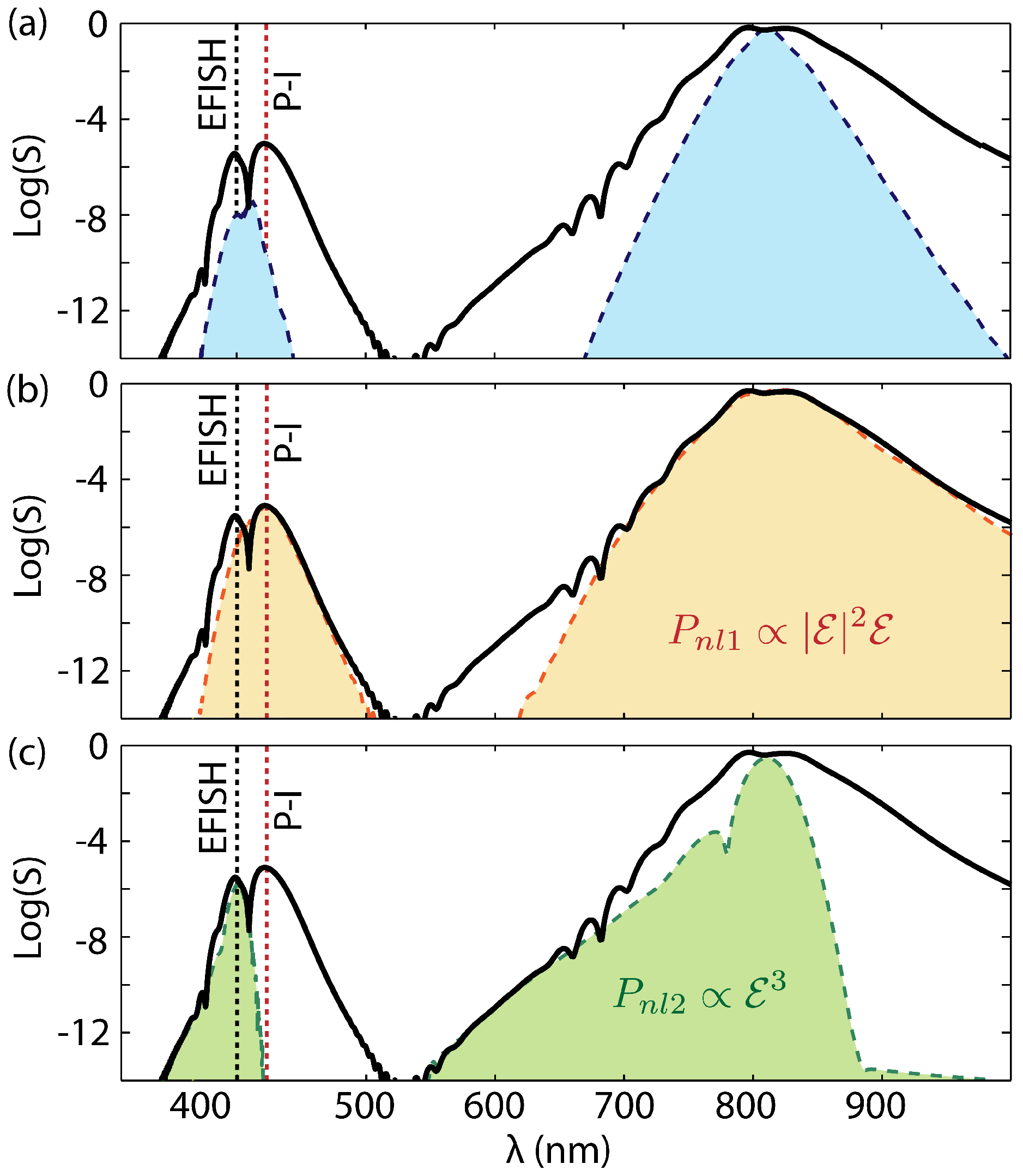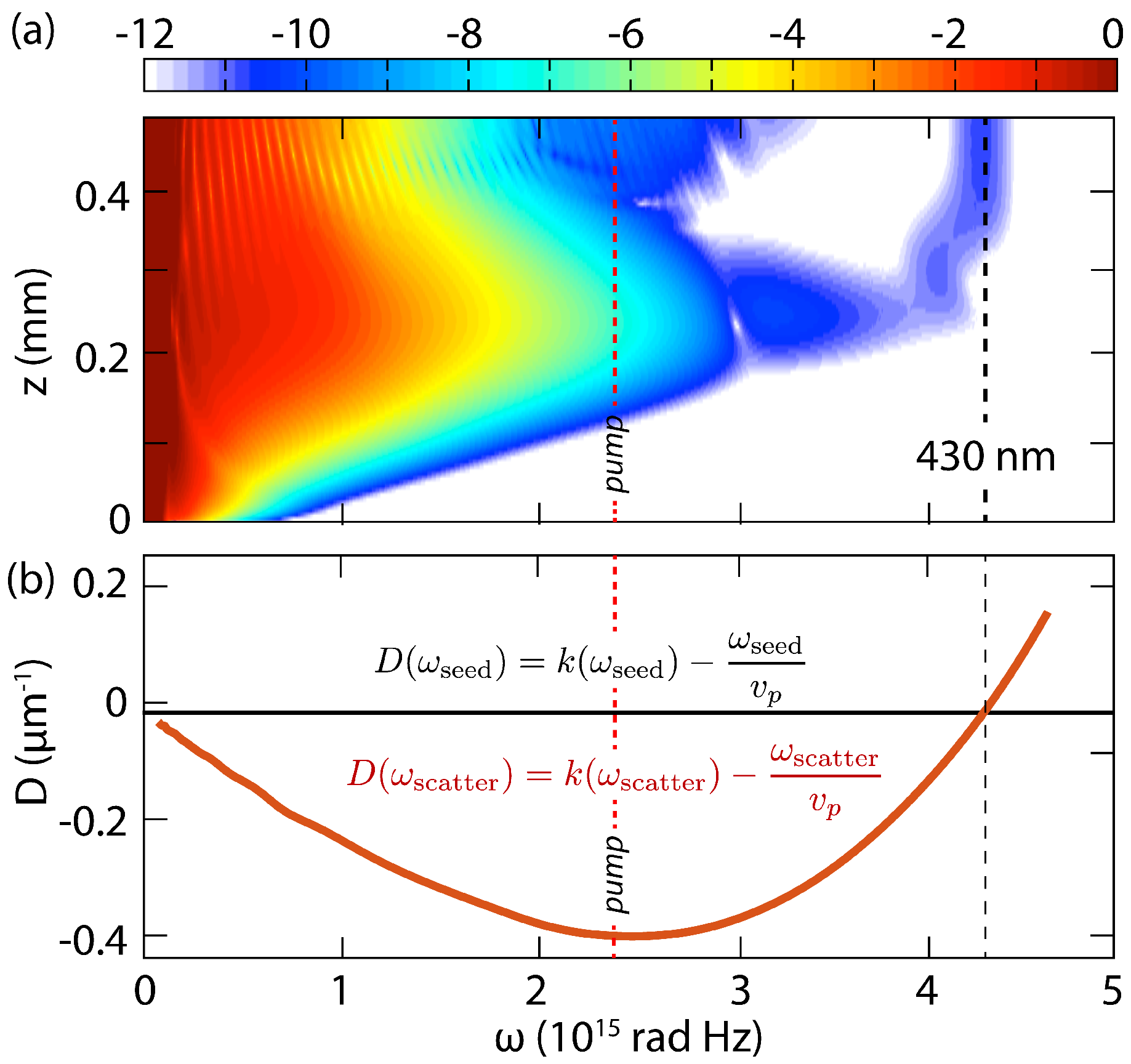Phase-Insensitive Scattering of Terahertz Radiation
Abstract
:1. Introduction
2. Experiments
Excluded Possible Origins of the UV Signal
- Fluorescence. We note that although diamond exhibits fluorescence in the analysed UV spectral regions, all the recorded UV signals only appear when the THz field is spatially and temporally overlapped to the 790 nm intense pulse. This observation rules out the possibility that the ≃430 nm signal is originating from a fluorescence process in diamond.
- Residual THz pump field. The multimesh filters used to remove the 1800 nm field from the THz beam path provide more than extinction. Given the low < efficiency of the THz generation process, it is essential to exclude the possibility that a residual 1800 nm field contributes to the onset of the ≃430 nm signal. To this end, we have first inserted a 1 mm thick window in the THz beam path and searched for evidence of UV radiation. In this case, no EFISH or 430 nm signal were observed. Since is transparent to IR radiation but opaque to THz, we concluded that THz is essential to generate the 430 nm signal. Further, we observed that the UV radiation was visible upon removing the window and inserting a paper filter, which both absorbs and scatters the 1800 nm radiation. We therefore exclude any possible role of a residual 1800 nm field in the generation of the 430 nm signal.
- EFISH. We note that the 430 nm peak cannot be explained by the EFISH mechanism described above. Indeed, its large shift from 395 nm—the wavelength of the pump second harmonic—cannot be justified by the broadening of the NIR pump pulse spectrum.
- Raman. Diamond is a well-known Raman-active crystal and has a large ∼1350 shift. The Raman-mediated wave mixing, , gives a product at 417 nm (c is the speed of light). This process is independent of the presence of the THz field, whereas in our measurement, the 430 nm signal only appeared when the THz field was injected in the crystal. Another Raman-mediated four-wave-mixing process that may lead to a signal around 417 nm is . This would require the presence of a Raman peak at , corresponding to a ∼884 nm wavelength, which does not appear in the recorded spectra. Finally, we note that the EFISH signal has energies <1 pJ, and is too low to directly excite a Raman red-shifted peak.
3. Model
3.1. Nonlinear Maxwell Equation Via Pseudospectral Space Domain Algorithm (1D + 1)
3.2. Coupled Nonlinear Envelope Equations
4. Conclusions
Acknowledgments
Author Contributions
Conflicts of Interest
References
- Federici, J.F.; Schulkin, B.; Huang, F.; Gary, D.; Barat, R.; Oliveira, F.; Zimdars, D. THz imaging and sensing for security applications—Explosives, weapons and drugs. Semicond. Sci. Technol. 2005, 20, S266–S280. [Google Scholar] [CrossRef]
- Wallin, S.; Pettersson, A.; Östmark, H.; Hobro, A. Laser-based standoff detection of explosives: A critical review. Anal. Bioanal. Chem. 2009, 395, 259–274. [Google Scholar] [CrossRef] [PubMed]
- Tonouchi, M. Cutting-edge terahertz technology. Nat. Photonics 2007, 1, 97–105. [Google Scholar] [CrossRef]
- Zhang, X.C.; Xu, J. Introduction to THz Wave Photonics; Springer US: Boston, MA, USA, 2010; pp. 1–246. [Google Scholar]
- Ohlhoff, C.; Meyer, C.; Lupke, G.; Loffler, T.; Pfeifer, T.; Roskos, H.G.; Kurz, H. Optical second-harmonic probe for silicon millimeter-wave circuits. Appl. Phys. Lett. 1996, 68, 1699. [Google Scholar] [CrossRef]
- Nahata, A.; Heinz, T.F. Detection of freely propagating terahertz radiation by use of optical second-harmonic generation. Opt. Lett. 1998, 23, 67. [Google Scholar] [CrossRef] [PubMed]
- Dai, J.; Xie, X.; Zhang, X.C. Detection of Broadband Terahertz Waves with a Laser-Induced Plasma in Gases. Phys. Rev. Lett. 2006, 97, 103903. [Google Scholar] [CrossRef] [PubMed]
- Karpowicz, N.; Dai, J.; Lu, X.; Chen, Y.; Yamaguchi, M.; Zhao, H.; Zhang, X.C.; Zhang, L.; Zhang, C.; Price-Gallagher, M.; et al. Coherent heterodyne time-domain spectrometry covering the entire “terahertz gap”. Appl. Phys. Lett. 2008, 92, 011131. [Google Scholar] [CrossRef]
- Clerici, M.; Faccio, D.; Caspani, L.; Peccianti, M.; Yaakobi, O.; Schmidt, B.E.; Shalaby, M.; Vidal, F.; Légaré, F.; Ozaki, T.; et al. Spectrally resolved wave-mixing between near- and far-infrared pulses in gas. New J. Phys. 2013, 15, 125011. [Google Scholar] [CrossRef]
- Li, C.Y.; Seletskiy, D.V.; Yang, Z.; Sheik-Bahae, M. Broadband field-resolved terahertz detection via laser induced air plasma with controlled optical bias. Opt. Express 2015, 23, 11436–11443. [Google Scholar] [CrossRef] [PubMed]
- Clerici, M.; Caspani, L.; Rubino, E.; Peccianti, M.; Cassataro, M.; Busacca, A.; Ozaki, T.; Faccio, D.; Morandotti, R. Counterpropagating frequency mixing with terahertz waves in diamond. Opt. Lett. 2013, 38, 178–180. [Google Scholar] [CrossRef] [PubMed]
- Efimov, A.; Yulin, A.V.; Skryabin, D.V.; Knight, J.C.; Joly, N.; Omenetto, F.G.; Taylor, A.J.; Russell, P. Interaction of an Optical Soliton with a Dispersive Wave. Phys. Rev. Lett. 2005, 95, 213902. [Google Scholar] [CrossRef] [PubMed]
- Efimov, A.; Taylor, A.J.; Yulin, A.V.; Skryabin, D.V.; Knight, J.C. Phase-sensitive scattering of a continuous wave on a soliton. Opt. Lett. 2006, 31, 1624–1626. [Google Scholar] [CrossRef] [PubMed]
- Petev, M.; Westerberg, N.; Moss, D.; Rubino, E.; Rimoldi, C.; Cacciatori, S.L.; Belgiorno, F.; Faccio, D. Blackbody Emission from Light Interacting with an Effective Moving Dispersive Medium. Phys. Rev. Lett. 2013, 111, 043902. [Google Scholar] [CrossRef] [PubMed]
- Clerici, M.; Peccianti, M.; Schmidt, B.E.; Caspani, L.; Shalaby, M.; Giguère, M.; Lotti, A.; Couairon, A.; Légaré, F.; Ozaki, T.; et al. Wavelength Scaling of Terahertz Generation by Gas Ionization. Phys. Rev. Lett. 2013, 110, 253901. [Google Scholar] [CrossRef] [PubMed]
- Couairon, A.; Mysyrowicz, A. Femtosecond filamentation in transparent media. Phys. Rep. 2007, 441, 47–189. [Google Scholar] [CrossRef]
- Kolesik, M.; Wright, E.M.; Moloney, J.V. Interpretation of the spectrally resolved far field of femtosecond pulses propagating in bulk nonlinear dispersive media. Opt. Express 2005, 13, 10729–10741. [Google Scholar] [CrossRef] [PubMed]
- Kolesik, M.; Tartara, L.; Moloney, J.V. Effective three-wave-mixing picture and first Born approximation for femtosecond supercontinua from microstructured fibers. Phys. Rev. A 2010, 82, 045802. [Google Scholar] [CrossRef]
- Philbin, T.G.; Kuklewicz, C.; Robertson, S.; Hill, S.; Konig, F.; Leonhardt, U. Fiber-Optical Analog of the Event Horizon. Science 2008, 319, 1367–1370. [Google Scholar] [CrossRef] [PubMed]
- Webb, K.E.; Erkintalo, M.; Xu, Y.; Broderick, N.G.R.; Dudley, J.M.; Genty, G.; Murdoch, S.G. Nonlinear optics of fibre event horizons. Nat. Commun. 2014, 5, 4969. [Google Scholar] [CrossRef] [PubMed]
- Belgiorno, F.; Cacciatori, S.L.; Clerici, M.; Gorini, V.; Ortenzi, G.; Rizzi, L.; Rubino, E.; Sala, V.G.; Faccio, D. Hawking Radiation from Ultrashort Laser Pulse Filaments. Phys. Rev. Lett. 2010, 105, 203901. [Google Scholar] [CrossRef] [PubMed]
- Agrawal, G. Nonlinear Fiber Optics; Academic Press: New York, NY, USA, 2001; p. 467. [Google Scholar]
- Dudley, J.M.; Genty, G.; Coen, S. Supercontinuum generation in photonic crystal fiber. Rev. Mod. Phys. 2006, 78, 1135–1184. [Google Scholar] [CrossRef]
- Gordon, J.P. Dispersive perturbations of solitons of the nonlinear Schrödinger equation. J. Opt. Soc. Am. B 1992, 9, 91–97. [Google Scholar] [CrossRef]
- Yulin, A.V.; Skryabin, D.V.; Russell, P.S.J. Four-wave mixing of linear waves and solitons in fibers with higher-order dispersion. Opt. Lett. 2004, 29, 2411–2413. [Google Scholar] [CrossRef] [PubMed]
- Efimov, A.; Taylor, A.J.; Omenetto, F.G.; Yulin, A.V.; Joly, N.Y.; Biancalana, F.; Skryabin, D.V.; Knight, J.C.; Russell, P.S. Time-spectrally-resolved ultrafast nonlinear dynamics in small-core photonic crystal fibers: Experiment and modelling. Opt. Express 2004, 12, 6498–6507. [Google Scholar] [CrossRef] [PubMed]
- Skryabin, D.V.; Yulin, A.V. Theory of generation of new frequencies by mixing of solitons and dispersive waves in optical fibers. Phys. Rev. E 2005, 72, 016619. [Google Scholar] [CrossRef] [PubMed]
- Zaitsev, A.M. Optical Properties of Diamond; Springer Berlin Heidelberg: Berlin/Heidelberg, Germany, 2001; p. 502. [Google Scholar]
- Tyrrell, J.C.A.; Kinsler, P.; New, G.H.C. Pseudospectral spatial-domain: A new method for nonlinear pulse propagation in the few-cycle regime with arbitrary dispersion. J. Mod. Opt. 2005, 52, 973–986. [Google Scholar] [CrossRef]
- Conforti, M.; Marini, A.; Tran, T.X.; Faccio, D.; Biancalana, F. Interaction between optical fields and their conjugates in nonlinear media. Opt. Express 2013, 21, 31239–31252. [Google Scholar] [CrossRef] [PubMed]
- Couairon, A.; Brambilla, E.; Corti, T.; Majus, D.; de J. Ramírez-Góngora, O.; Kolesik, M. Practitioner’s guide to laser pulse propagation models and simulation. Eur. Phys. J. Spec. Top. 2011, 199, 5–76. [Google Scholar] [CrossRef]
- Boyd, R.W. Nonlinear Optics; Academic Press: New York, NY, USA, 2008. [Google Scholar]
- Rubino, E.; Lotti, A.; Belgiorno, F.; Cacciatori, S.L.; Couairon, A.; Leonhardt, U.; Faccio, D. Soliton-induced relativistic-scattering and amplification. Sci. Rep. 2012, 2, 932. [Google Scholar] [CrossRef] [PubMed]
- Conforti, M.; Baronio, F.; Trillo, S. Resonant radiation shed by dispersive shock waves. Phys. Rev. A 2014, 89, 013807. [Google Scholar] [CrossRef]




© 2017 by the authors. Licensee MDPI, Basel, Switzerland. This article is an open access article distributed under the terms and conditions of the Creative Commons Attribution (CC BY) license ( http://creativecommons.org/licenses/by/4.0/).
Share and Cite
Petev, M.; NiclasWesterberg; Rubino, E.; Moss, D.; Couairon, A.; Légaré, F.; Morandotti, R.; Faccio, D.; Clerici, M. Phase-Insensitive Scattering of Terahertz Radiation. Photonics 2017, 4, 7. https://doi.org/10.3390/photonics4010007
Petev M, NiclasWesterberg, Rubino E, Moss D, Couairon A, Légaré F, Morandotti R, Faccio D, Clerici M. Phase-Insensitive Scattering of Terahertz Radiation. Photonics. 2017; 4(1):7. https://doi.org/10.3390/photonics4010007
Chicago/Turabian StylePetev, Mihail, NiclasWesterberg, Eleonora Rubino, Daniel Moss, Arnaud Couairon, François Légaré, Roberto Morandotti, Daniele Faccio, and Matteo Clerici. 2017. "Phase-Insensitive Scattering of Terahertz Radiation" Photonics 4, no. 1: 7. https://doi.org/10.3390/photonics4010007
APA StylePetev, M., NiclasWesterberg, Rubino, E., Moss, D., Couairon, A., Légaré, F., Morandotti, R., Faccio, D., & Clerici, M. (2017). Phase-Insensitive Scattering of Terahertz Radiation. Photonics, 4(1), 7. https://doi.org/10.3390/photonics4010007




